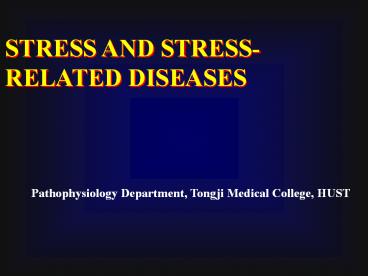STRESS AND STRESS-RELATED DISEASES - PowerPoint PPT Presentation
1 / 42
Title: STRESS AND STRESS-RELATED DISEASES
1
STRESS AND STRESS-RELATED DISEASES
Pathophysiology Department, Tongji Medical
College, HUST
2
Contents
- Concepts general adaptation syndrome, stress,
stressor - Mechanism-stress response
- Neuroendocrine LC-NE/sympathetic, HPA
- Humoral and cellular APP, HSP
- Functional metabolic alteration
- Stress-related diseases stress ulcer
- Prevention and treatment principle
- Case discussion
3
Hans Selye (1907-1982)
4
General Adaptation Syndrome (GAS)
Specific symptoms
Different diseases
Non-specific symptoms
A serial of non-specific signs and symptoms
caused by various strong stimulus.
5
General Principle of Stress
Stimulus
Disturbance of homeostasis
Adaptative response
Homeostasis
Diseases or symptoms
A general adaptative response in order to cope
with the altered homeostasis.
6
Stages of GAS
Stimulus
Alarm reaction
Adaptation
Exhaustion
Diseases
Relaxation
7
Stress Definition
Non-specific response of the body to any demand
made upon it.
8
Stressor
Any stimuli that elicit the stress response
External Internal Psycho-social
Physical Psychological
Short-term (acute) Long-term (chronic)
Stressors noise, danger, infection on-going
highly pressured work, long-term relationship
problems, loneliness, and persistent financial
worries.
9
Importance of Stress
Without stress, there would be no life
Pleasant stress (eustress) wellness
Unpleasant stress (distress) disease
10
Focus of Stress Mechanism
Stimulus
Disturbance of homeostasis
Alarm reaction
Adaptative response
Diseases or symptoms
11
Stress Responses
Neuroendocrine
Humeral
Cellular
12
Neuroendocrine Response
- Locus ceruleus-norepinephrine (LC/NE)
/sympathetic-adrenal medulla axis
- Hypothalamic-pituitary-adrenal (HPA) axis
13
Release of Catecholamines
Dopamine Norepinephrine Epinephrine (adrenaline)
14
Role of Catecholamine
Central Arousal , vigilance and memory
(Alarm stage)
Peripheral
Heart Blood redistribution Respiratory
rate Gastrointestinal activity Insulin Glucagons
15
(No Transcript)
16
CNS Response
amygdala
emotional response
Catecholamines
hippocampus
long-term memory
short-term memory, concentration, and rational
thought
the front of the brain
17
Diencephalons
18
Hormones Released
Corticotrophin-releasing hormone (CRH)
Adrenocorticotropic hormone (ACTH)
Glucocorticoid hormones (cortisol and cortisone)
Others (growth hormones, thyroid hormone,
reproductive hormones
(Large surgical operation, long term effect)
19
Role of Glucocorticoid
Blood glucose?
Protection
Lysosome
GC
Other hormones
Cardiovascular system
Immune system?
20
Interaction of LC and HPA
Amygdala
Hippocampus
Locus ceruleus
Paraventricular nucleus
Spinal cord
Adrenal cortex
21
Humoral Response
Acute phase protein
C-reactive protein
Serum amyloid A
Ceruloplasmin (chelating protein)
(Severe burn injury)
22
Complement activation
Superoxide reduction
APP
Bind phosphocholine
Cytokine secretion
23
Cellular Response
Heat shock protein
e.g., HSP70
Chaperone protein folding, assembly,
translocation, degradation
24
Structure of HSP
25
Electron micrograph of HSP70 in scrapie infected
cell
A, Endosome-lysosome related multivesicular
dense body B, HSP70 specific glod particles C,
HSP70 specific particles in the
cytoplasm.
26
Regulation of HSP expression
27
Understanding Stress Mechanism at Cellular and
Molecular levels
Stimulus
Intracellular protein (e.g., HSP)
Release of hormones (e.g., GC) or
neurotransmitters (e.g., NA)
Neuroendocrine response
28
Functional and Metabolic Alteration
29
Memory, Concentration, and Learning Effect of
Acute Stress on Memory. Subjects taking cortisone
performed significantly worse on memorization
tests than those taking the placebo did.
Effect of Chronic Stress on Memory. Prolonged
exposure to cortisol to shrinkage in the
hippocampus, the center of memory.
30
Heart rate and blood pressure increase Blood
flow may increase 300 to 400 Breathing becomes
rapid and takes in more oxygenDryness and
difficulty in talking Spasms of the throat
muscles, difficult to swallow Cool, clammy,
sweaty skin Scalp tightens, hair stand
up Digestive activity shuts down (appetite,
ulcer, diarrhea) Genito-urinary system
disturbance of hormone.
31
Stress
Immune system
Neuroendocrine system
CRH
TNF-a IL-1 IL-6
CRH-R1
b-endorphine ACTH
32
Stress and Disease
33
Stress Ulcer
Mucosal damage or lesion of the stomach or
duodenum in critical illness or severely stressed
situation.
Gastrointestinal mucosal ischemia
Counter-diffusion of gastric hydrogen ion to
mucosa
34
Psychological Effects of Stress In one study,
two-thirds of subjects who experienced a
stressful situation had nearly six times the risk
of developing depression within that month. Some
evidence suggests that repeated release of stress
hormone disrupts normal levels of serotonin which
is critical for feelings of well-being.
35
Post-Traumatic Stress Disorder Symptoms
Posttraumatic Stress Disorder is a psychiatric
disorder that can occur following the experience
or witnessing of life-threatening events such as
military combat, natural disasters, terrorist
incidents, serious accidents, or violent personal
assaults like rape. People who suffer from PTSD
often relive the experience through nightmares
and flashbacks, have difficulty sleeping, and
feel detached or estranged, and these symptoms
can be severe enough and last long enough to
significantly impair the person's daily life.
36
Other Gastrointestinal Problems (Irritable bowel
syndrome, Crohn's disease or ulcerative colitis)
Heart Disease (Essential hypertension, coronary
artery disease, arrhythmias)
Immune Disorders (Rheumatoid arthritis, multiple
sclerosis)
37
Sexual and Reproductive Dysfunction
Sexual Function Premenstrual Syndrome
Fertility, miscarriage, etc.
38
Case Presentation
A 32-year-old man was severely burned (78 of
skin surface, II degree) by gasoline.
On the second day, the patient vomited about 200
ml of coffer-colored bloody juice.
a
Endoscopic examination revealed scattered
erosions (2 mm in diameter) throughout the
stomach. A bigger ulcer was oozing .
Bleeding was stopped by endoscopic hemostasis.
39
Principle of Treatment and Prevention
Treating stress is a very important component in
a medical regimen. Some evidence exists that
stress management programs may reduce the risk of
heart events (eg, heart attack) by up to 75 in
people with heart disease.
40
"Fight for your highest attainable aim but never
put up resistance in vain."
"Fight for your highest attainable aim but never
put up resistance in vain."
Hans Selye
41
General Guidelines
Rule One - Find your own purpose in life, that
fits your own personal stress
level. Rule Two - Control your emotional level
by recognizing situations as
being either life-
threatening or non-life-threatening. Rule
Three - Collect the goodwill and appreciation
of others.
42
Thank you































